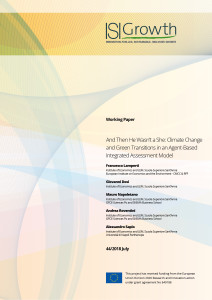In this work, we employ an agent-based integrated assessment model to study the likelihood of transition to green, sustainable growth in presence of climate damages. The model comprises heterogeneous fossil-fuel and renewable plants, capital- and consumption-good firms and a climate box linking greenhouse gasses emission to temperature dynamics and microeconomic climate shocks affecting labour productivity and energy demand of firms. Simulation results show that the economy possesses two statistical equilibria: a carbon-intensive lock-in and a sustainable growth path characterized by better macroeconomic performances. Once climate damages are accounted for, the likelihood of a green transition depends on the damage function employed. In particular, aggregate and quadratic damage functions overlook the impact of climate change on the transition to sustainability; to the contrary, more realistic micro-level damages are found to deeply influence the chances of a transition. Finally, we run a series of policy experiments on carbon (fossil fuel) taxes and green subsidies. We find that the effectiveness of such market-based instruments depends on the different channels climate change affects the economy through, and complementary policies might be required to avoid carbon-intensive lock-ins.
And Then He Wasn’t a She: Climate Change and Green Transitions in an Agent-Based Integrated Assessment Model
Institute of Economics and LEM, Scuola Superiore Sant’Anna European Institute on Economics and the Environment – CMCC & RFF
Institute of Economics and LEM, Scuola Superiore Sant’Anna
Institute of Economics and LEM, Scuola Superiore Sant’Anna OFCE-Sciences Po and SKEMA Business School
Institute of Economics and LEM, Scuola Superiore Sant’Anna OFCE-Sciences Po and SKEMA Business School
Institute of Economics and LEM, Scuola Superiore Sant’Anna Università di Napoli Parthenope

